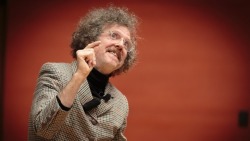New York’s Park Avenue Armory’s current major exhibition is a retrospective of Martin’s Creed’s work over two decades. Viewers will experience films and installations of nipples stiffening and softening, flaccid penises firming, and a young woman squatting to defecate. One room’s back door opens and closes, inviting one to explore a small, dark opening.
The exhibition’s centerpiece, “Open and Closing Mouth,” is a film of an older woman, the artist’s mother, with her mouth opening to show a glob of creamy white stuff on her tongue.
Let’s set aside any “That’s not art!” indignations for now and take Mr. Creed as a serious man with a serious purpose. Art is a form of self-expression, he tells us. In his case, “it has to do with the horrible insides coming out.”
At the same time, art made public comes from a desire to generate experiences in its audience. The artist wants to express himself, of course, but he also wants you and me to have specific experiences—and he wants to express himself as a person who wants to make us have certain experiences. About his Turner Prize-winning The Lights Going On and Off, Mr. Creed says, “the real reason I made that work was because I loved switching the lights off and on to annoy people.”
Other works are darker and troubled evocations. There is “this monster inside me,” he tells us, which he both feels compelled to reveal and fears revealing. So the exhibition’s many metaphorical orifices ask us to peer into Mr. Creed’s soul and feel with him his dominating fears, guilts, and sicknesses.
Yet why should we care about Mr. Creed’s particular obsessions? Not to disparage the value of his products as a form of therapy and self-exploration—but why ought the rest of us devote our time to a sad sack who wants to annoy us?
Because he is not alone in the art world. And because its high custodians have told us that we ought to. The significance of the Turner Prize in Britain and a major retrospective at New York’s Armory is they are the art world’s stamps of high approval and an authoritative signal to the rest of us to pay attention. Mr. Creed matters as a symbol of our cultural leaders’ judgments of what is truly important.
His output does speak to the concerns of a generation or more, with nods to Tracey Emin’s semen-stained bedsheets, Eric Fischl’s Freudian-masturbatory children, Paul McCarthy’s animal buggery, and Millie Brown’s vomit creations. For decades now, these have been commended to our serious attention. And with good reason—for who can deny that the disturbed is part of the human condition?
At the same time, can we also deny that the art world seems to have been stuck for a long time in a few thematic ruts and to be missing major parts of the human story? Life expectancy has gone up dramatically over the last century and infant mortality rates have plummeted, meaning that more humans beings have gotten a chance at this fragile, precious thing called life. Human rights battles for women, racial and ethnic minorities, and gays have been engaged seriously and liberating victories have been won. Every year brings new scientific beauties and technological marvels, opening the universe for us to explore in unimagined ways.
While we all have our fears and dark anguishes, those advances too are a features of the human condition. And that is precisely where our artists most need to be with their creativity, sensitivity, and openness to experience the world as it really is.
Perhaps the symbolic lesson of Mr. Creed’s exhibition is that art is indeed a philosophical enterprise and always reflects its practitioners’ strongest beliefs and values. When will our contemporary art leadership open to embrace the human condition more fully and allow expressions of authentic human dignity and exuberance to occupy cultural space with equally authentic self-loathing and despair?
Stephen R. C. Hicks, Ph.D.
Stephen Hicks is professor of philosophy at Rockford University, Illinois, where he teaches courses in aesthetics and modern intellectual history.
Source: Frank Rose, “Martin Creed Unleashes His Demons in ‘Back Door’ at the Park Avenue Armory,” The New York Times, June 7, 2016.
Related:
“Why Art Became Ugly”. Translations into German, Korean, Spanish, and Portuguese.
“Taking Modern Artists at Their Word”. Translation into Portuguese.
“The Most Important Artist of the Century”. Translation into Portuguese.


See these passages below from my novel CROSSPOINTS A Novel of Choice, published first ten years ago (and still available) to show that this has been going on for a long, long time, and the so-called taste makers never seem to tire of it. This is soooo passe’ even in a decadent art world.
From the novel:
“Plus for us visual artists continuing to explore our bodily functions, of course, especially the degrading and thoroughly messy acts of shit and sex. Potty humor is out but self-loathing is still in, so along
with ‘reality’ perversaties, we’re also continuing to explore the shame we all have over our animal bodies, including our disgusting fluids. Look around you! If you didn’t spend half your time on vacation and the other half filling corporate commissions, and then complicate your life by packing your head with rocks from that Greek archaeologist for months, you’d know that these preoccupations have been in full swing for a long time now.”
Adria smiled indulgently at Leon’s quizzical expression. “Don’t worry, Babydoll. I like your sexy mess. You’ve just been so downtime lately that I forgot the taste of it. Anyway,” she chatted blithely on, “by continuing to modernize primitavism, medeivalism and mysticism, all living creatures are again being held sacred as interdependent organisms. Even our planet is unquestionably considered a living entity now, so it can become another victim of human oppression for us to save.”
Pingback: Drawing the Line between Pornography and Art – Michael Newberry